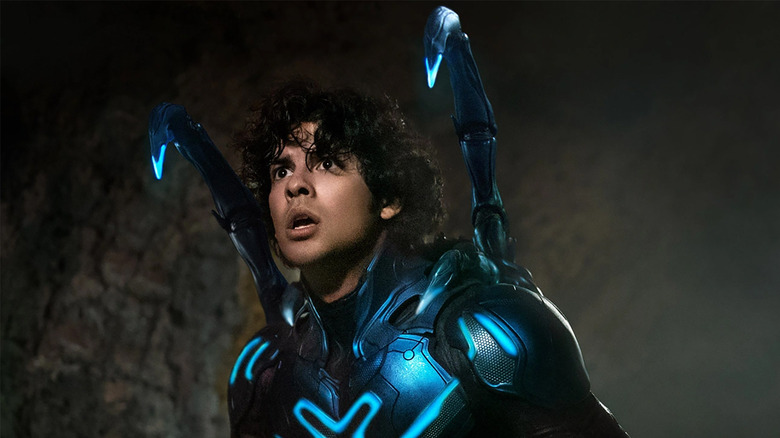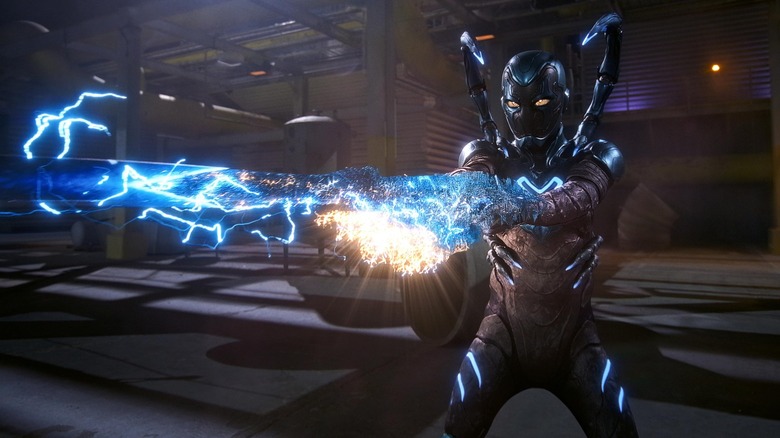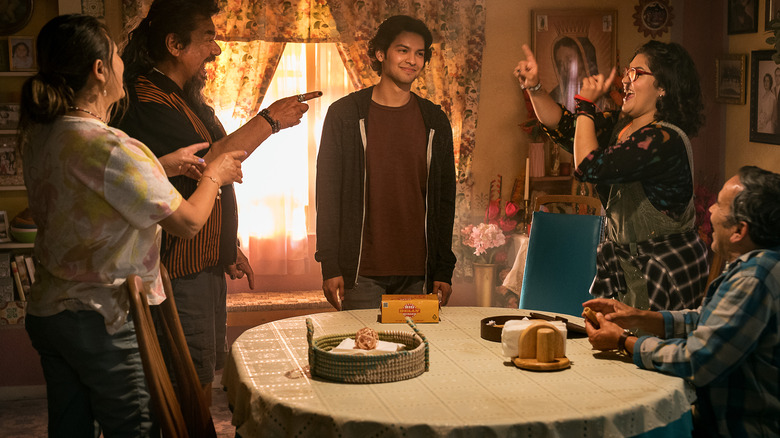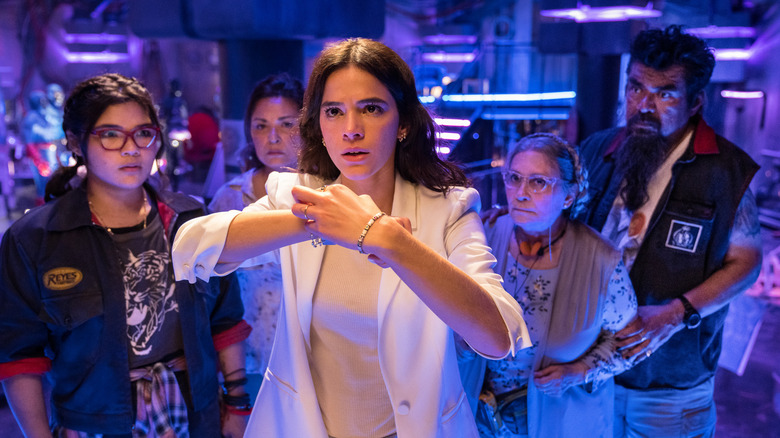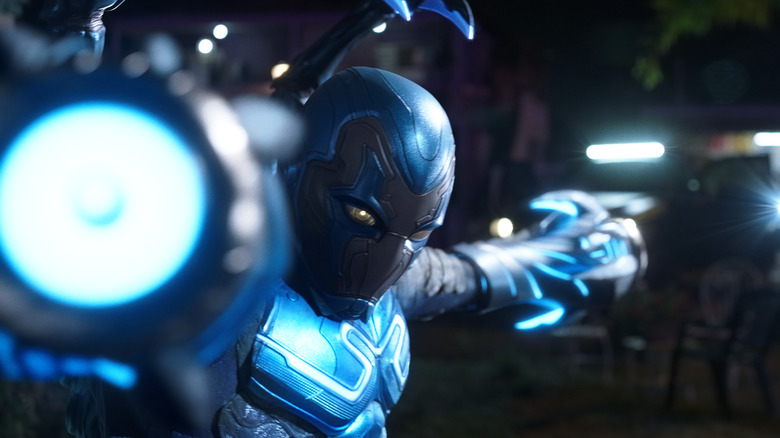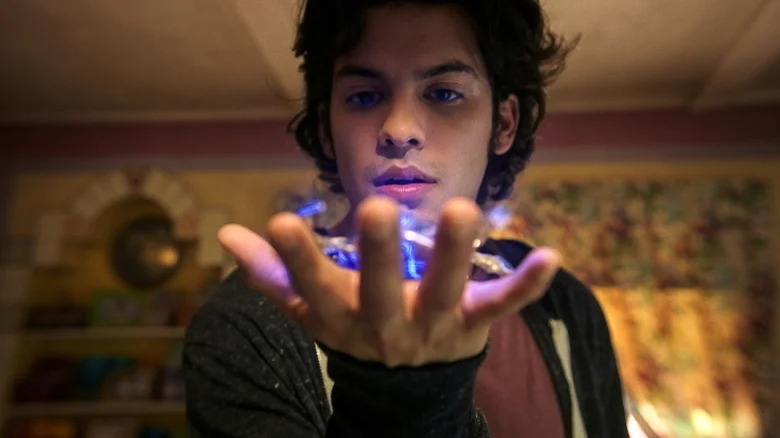Blue Beetle Ending Explained: Family Is Everything
This article contains spoilers for "Blue Beetle."
The DC Extended Universe is on its way out, but before it leaves and is replaced by the new DC Universe helmed by James Gunn and Peter Safran, we have one brand new superhero to meet: Jaime Reyes in "Blue Beetle."
This is an opportunity for DC to introduce something rare in superhero movies and TV, but which is becoming more common: a family. Like Shazam, Miles Morales, and Ms. Marvel, Jamie Reyes' biggest asset is that he is not alone, and he has a family that lovingly supports him and very much knows his secret.
As significant as Miles Morales was for Latino superhero representation, he is biracial and the "Into the Spider-Verse" films rightly spend their time split between his two backgrounds. Meanwhile, other Latino superheroes like Xóchitl Gómez's América Chávez and Sasha Calle's Supergirl were barely used by their respective films and didn't focus on their ethnic backgrounds. But "Blue Beetle" is unequivocally and unapologetically Mexican.
So far, "Blue Beetle" has had favorable fractions from critics, praising the emotional core of the film and its cultural specificity. It is a universal story, sure, but the film never tries to pass the characters' cultural background as anything other than authentically Mexican, and it is much better for it. It may not be breaking the mold, but the film plays with years' worth of expectations for what a superhero origin story is, and it refreshes just enough to feel fresh and special.
In case you have questions after seeing the film, here's the ending of "Blue Beetle," explained.
What you need to remember about the plot of Blue Beetle
We start the film with a cheeky title sequence that shows the scarab that gives Blue Beetle its powers flying across the cosmos, bouncing off asteroids and planets before arriving on planet Earth at some point roughly a millennia ago. There are even other green and yellow scarabs seen in the background, teasing potential sequel possibilities.
The scarab has been part of humanity's history forever, influencing technology and even worshipped in Mesoamerican cultures. That sense of history permeates throughout "Blue Beetle," from the history of the character itself to how the mantle of Blue Beetle passes down from one generation to the next. Not only does Ted Kord play into the story, but even Dan Garrett, too, so the history of Mexican and Latino American resilience impacts Jaime himself in a significant way.
In the present day, we meet Jaime Reyes (Xolo Maridueña) as he arrives home to the fictional Palmera City after studying pre-law at college. But celebration takes a turn when he discovers things are rather bleak at home. His father (Damián Alcázar) recently had a heart attack, his business is failing, and the family will lose their home soon — and they hid all the bad news from him. Unfortunately, Jaime loses the job he desperately needs on his first day by speaking out of turn in front of his boss, who just so happens to be Susan Sarandon's Victoria Kord, the woman running the company who is taking over the Reyes' family's neighborhood and on the hunt for the scarab in order to help create an army of OMACs (One Man Army Corps)
Thankfully, Jaime also meets Jenny (Bruna Marquezine), heir to Kord Industries and a thorn in Victoria's side. But rather than thank Jamie for sticking up for her when she's being berated by Victoria and her henchman Carapax (Raoul Max Trujillo) by giving him a job, unfortunately, she gives him the alien scarab and makes the huge mistake of asking a Latino dude to guard a box and not be tempted to look inside.
What happened at the end of Blue Beetle?
After realizing that Jaime has managed to activate the scarab and unlock its power (something not even the previous Blue Beetle had managed to do), Victoria Kord sends an elite kill squad and Carapax (Raoul Trujillo), equipped with an early version of the OMAC technology, to the Reyes' family home to find Jaime. In the process, Jaime's father, Alberto, has a heart attack and dies, and Jaime is kidnapped after Carapax manages to sever the neural connection between him and the scarab.
Victoria brings Jaime to a private island off the coast of Cuba, which Kord Industries bought from Batista before the revolution. There, she has a scientist that she keeps calling the wrong name (played by Harvey Guillén), and he reluctantly copies the scarab's code and puts it into her thousands of OMAC devices so she can create supersoldiers. Oh, and she also injects the code into Carapax, who gets upgraded to a giant, evil cyborg, looking like a Bigfoot-sized Jaeger.
Meanwhile, Jaime, like the characters of a recent superhero movie also about family, is being milked for his connection to the scarab, the power literally drained away from him along with his life. Things look dire.
Thankfully, Jenny and the Reyes family use the previous Blue Beetle's flying vehicle, The Bug, to rescue Jaime. They also arm themselves to the teeth with cool sci-fi weapons straight out of "Spy Kids," like a Nintendo Power Glove that functions as a holographic shield and gauntlet fist, or a gatling gun that Nana uses. Yeah, Nana used to be a revolutionary in her prime, just a thing grandmas do, and she hates imperalistas.
I don't have friends, I got family
Right as the scarab's code is finished getting copied and Jaime is about to be killed, he has a vision of his dad in the DC equivalent of the ancestral plane from "Black Panther." It is a beautiful scene inspired by the classic magical realist Mexican film "Macario" from the '60s, set in the Reyes family home, but now covered in candles that extend to infinity. Alberto tells Jaime that his family has always been resilient, that they've overcome much worse.
There's a word that is said a lot in the film, "ánimo," which is often used as "cheer up," but it has a more melancholic tone than that. It is a word that not only calls for hope that things will get better, but recognizes the hardships one goes through. It is the encapsulation of everything the Reyes represent, especially the Mexican and Latino American spirit of resilience. As Nana tells Milagro after Alberto dies, "We can cry later. But we need to get this done now." We mourn what we lose, but we keep going forward. They use their pain to fuel their power. In telling a very culturally specific story about a Mexican family, "Blue Beetle" tells one of the most universal stories in the DC Universe.
Having regained his confidence, Jaime fully embraces the scarab, and the two synchronize like it's Shinji inside the robot that contains his dead mother's soul, unlocking the alien device's full potential. He manages to beat Carapax, and he almost lets his anger get the better of him by killing the soldier. But the scarab shows Jaime the real man behind the cyborg, revealing him to be a victim of American imperialism, a child soldier of the School of the Americas, who is now but a slave to Victoria Kord. Carapax, having recuperated his lost memory, decides to sacrifice himself and take his boss with him, so she can't do anyone else harm.
What the end of Blue Beetle could mean for the franchise
With Victoria dead, Jenny takes over the company and vows to stop their military work. Instead, she chooses to focus on her dad's legacy of helping people, starting with giving Edge Keys back to the community and stopping its gentrification. Jenny and Jaime finally kiss after a whole movie teasing their potential romance, and the two fly off into the sunset thanks to the scarab now sharing control with Jaime.
The film's main credits scene teases the return of a legacy hero: Ted Kord, the second Blue Beetle, who has spent the past few years trapped... who knows where. Or is it who knows when? Perhaps the way to bring the character into the fold is not by his own, but by bringing in Blue Beetle and Booster Gold, the hero from the future. Their stories are often comedic in nature and deeply weird, and Booster Gold has already been confirmed to be part of the new DC Universe. Having Ted Kord be around while Jaime is Blue Beetle would give DC something we haven't really seen in their movies before: a passing of the torch, a mentor and mentee superhero, and a sense of legacy that is integral to DC comics – and also something that makes "Young Justice" so special.
There's also the matter of the OMACs, which were seemingly destroyed, but could easily return. Perhaps their patent is still out there, somewhere, ready to be bought by Bruce Wayne as part of his program to study and monitor superheroes and villains in the lead-up to "Infinite Crisis" in the comics.
More importantly, and more likely, Blue Beetle could a big part of the Justice League International, which seems to be what James Gunn is building up to. Though the original comics include Ted Kord, it'd be rather easy to swap him with Jaime.
What's next for Jaime Reyes?
Is Blue Beetle part of the new DC Universe? That is a tricky question, and the biggest question mark surrounding the film. As of now, it seems like James Gunn and Peter Safran are starting from scratch, discarding everything and anything from the old universe. And yet, James Gunn has repeatedly kept the door open for Jaime specifically.
This went further last month, when James Gunn addressed fan questions and clarified that the first movie in the DC Universe is "Superman Legacy." But he's also said (via GamesRadar) that the first character in the DC Universe is Blue Beetle.
This could work relatively easily. As Gunn has said in the past, the film is "totally disconnected" from any specific DC universe, unlike something like "Shazam," which directly references Zack Snyder's take on DC. Though "Blue Beetle" references Batman, Superman and The Flash by dropping their names, it could be any version of those superheroes. We could see these characters incorporated into the larger DC Universe without changing much. In a universe that isfilled with superheroes, what's one more?
"Blue Beetle" is playing in theaters everywhere now.
